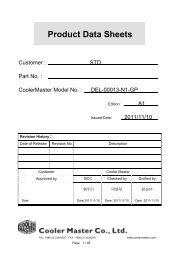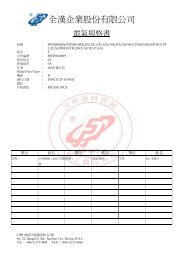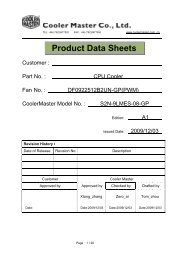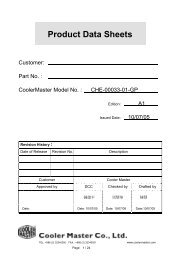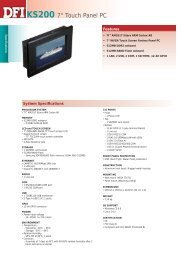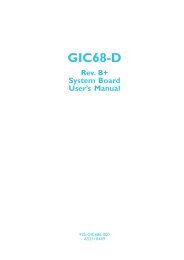i910GML-DCQI / i915GM-DCQI - Rosch Computer GmbH
i910GML-DCQI / i915GM-DCQI - Rosch Computer GmbH
i910GML-DCQI / i915GM-DCQI - Rosch Computer GmbH
You also want an ePaper? Increase the reach of your titles
YUMPU automatically turns print PDFs into web optimized ePapers that Google loves.
<strong>i910GML</strong>-<strong>DCQI</strong>C6 /<br />
<strong>i915GM</strong>-<strong>DCQI</strong><br />
Intel ® 910GMLE µFC-BGA 479 (or 915GM µFC-PGA 478)<br />
Pentium ® M / Celeron ® M Mini ITX Main Board<br />
User’s Manual<br />
Ver. 1.00
<strong>i910GML</strong>-<strong>DCQI</strong>C6/ <strong>i915GM</strong>-<strong>DCQI</strong><br />
Contents<br />
Safety Information ..........................................................................................................4<br />
Technical Support ............................................................................................................5<br />
Conventions Used in This Guide ....................................................................................5<br />
Packing List .......................................................................................................................6<br />
Revision History ...............................................................................................................7<br />
Specifications Summary..................................................................................................8<br />
Block Diagram (<strong>i910GML</strong>-<strong>DCQI</strong>C6).............................................................................11<br />
Block Diagram (<strong>i915GM</strong>-<strong>DCQI</strong>) ...................................................................................12<br />
Production Introduction ...............................................................................................14<br />
1.1 Before you Proceed ................................................................................................14<br />
1.2 Motherboard Overview............................................................................................15<br />
2<br />
1.2.1 Placement Direction ....................................................................................................................... 15<br />
1.2.2 Screw Holes ................................................................................................................................... 15<br />
1.3 Motherboard Layout ................................................................................................16<br />
1.3.1 Layout Content List ........................................................................................................................ 17<br />
1.4 Central Processing Unit (CPU) (for <strong>i915GM</strong>-<strong>DCQI</strong> only).........................................19<br />
1.4.1 Installing the CPU........................................................................................................................... 20<br />
1.4.2 Installing the CPU Heatsink and Fan .............................................................................................22<br />
1.4.3 Uninstalling the CPU Heatsink and Fan......................................................................................... 24<br />
1.5 System Memory ......................................................................................................25<br />
1.5.1 DIMM Sockets Location ................................................................................................................. 25<br />
1.5.2 Memory Configurations .................................................................................................................. 26<br />
1.5.3 Installing a DDR2 DIMM................................................................................................................. 27<br />
1.5.4 Removing a DDR2 DIMM............................................................................................................... 27<br />
1.6 Expansion Slots ......................................................................................................28<br />
1.6.1 Installing an Expansion Card ......................................................................................................... 28<br />
1.6.2 Configuring an Expansion Card ..................................................................................................... 28<br />
1.6.3 Standard Interrupt Assignments..................................................................................................... 29<br />
1.6.4 PCI Slots ........................................................................................................................................ 29<br />
1.7 Jumpers ..................................................................................................................30<br />
1.7.1 Clear CMOS (CLRRTC1)............................................................................................................... 30<br />
1.7.2 COM Port 1, 2 RI/+5V/+12V Selection (JCOMPWR1)................................................................... 31<br />
1.7.3 COM Port 3, 4 RI/+5V/+12V Selection (JCOMPWR2)................................................................... 31<br />
1.7.4 CPU VCC Voltage Select (VCCA_SEL1)....................................................................................... 32
Contents<br />
User’s Manual<br />
1.8 Connectors..............................................................................................................33<br />
1.8.1 Rear Panel Connectors.................................................................................................................. 33<br />
1.8.2 Amplifier Connector (AMPJ1)......................................................................................................... 35<br />
1.8.3 CPU Fan Connector (CPU_FAN1)................................................................................................. 35<br />
1.8.4 System Fan Connector (SYS_FAN1)............................................................................................. 36<br />
1.8.5 Serial Port Connector 3 (COM3) .................................................................................................... 36<br />
1.8.6 Serial Port Connector 4 (COM4) .................................................................................................... 37<br />
1.8.7 Front Headphone Connector (F_AUDIO1)..................................................................................... 37<br />
1.8.8 System Panel Connector (F_PANEL1).......................................................................................... 38<br />
1.8.9 USB 2.0 Connector (FRONT_USB1, FRONT_USB2) ................................................................... 39<br />
1.8.10 Primary IDE Connector (IDE1)................................................................................................... 40<br />
1.8.11 ATX Power Connector (JATXPWR1) ........................................................................................ 41<br />
1.8.12 LCD Inverter Connector (JBKLT1)............................................................................................. 42<br />
1.8.13 LVDS Connector (JLVDS1) ....................................................................................................... 42<br />
1.8.14 Digital I/O Connector (JDIO)...................................................................................................... 43<br />
1.8.15 Serial ATA Connector 1 & 2 [Black] (SATA1, SATA2) .............................................................. 43<br />
<strong>i910GML</strong>-<strong>DCQI</strong>C6 / <strong>i915GM</strong>-<strong>DCQI</strong><br />
3
<strong>i910GML</strong>-<strong>DCQI</strong>C6/ <strong>i915GM</strong>-<strong>DCQI</strong><br />
Safety Information<br />
Electrical safety<br />
� To prevent electrical shock hazard, disconnect the power cable from the electrical<br />
outlet before relocating the system.<br />
� When adding or removing devices to or from the system, ensure that the power cables<br />
for the devices are unplugged before the signal cables are connected. If possible,<br />
disconnect all power cables from the existing system before you add a device.<br />
� Before connecting or removing signal cables from the motherboard, ensure that all<br />
power cables are unplugged.<br />
� Seek professional assistance before using an adapter or extension cord. These<br />
devices could interrupt the grounding circuit.<br />
� Make sure that your power supply is set to the correct voltage in your area. If you are<br />
not sure about the voltage of the electrical outlet you are using, contact your local<br />
power company.<br />
� If the power supply is broken, do not try to fix it by yourself. Contact a qualified service<br />
technician or your retailer.<br />
Operation safety<br />
� Before installing the motherboard and adding devices on it, carefully read all the<br />
manuals that came with the package.<br />
� Before using the product, make sure all cables are correctly connected and the power<br />
cables are not damaged. If you detect any damage, contact your dealer immediately.<br />
� To avoid short circuits, keep paper clips, screws, and staples away from connectors,<br />
slots, sockets and circuitry.<br />
� Avoid dust, humidity, and temperature extremes. Do not place the product in any area<br />
where it may become wet.<br />
� Place the product on a stable surface.<br />
� If you encounter technical problems with the product, contact a qualified service<br />
technician or your retailer.<br />
4<br />
The symbol of the crossed out wheeled bin indicates that the product<br />
(electrical and electronic equipment) should not be placed in<br />
municipal waste. Check local regulations for disposal of electronic<br />
products.
Technical Support<br />
User’s Manual<br />
If a problem arises with your system and no solution can be obtained from the user’s<br />
manual, please contact your place of purchase or local distributor. Alternatively, please try<br />
the following help resources for further guidance. Visit the Advansus website for FAQ,<br />
technical guide, BIOS updates, driver updates, and other information:<br />
http://www.advansus.com.tw/Support/Support.asp<br />
Conventions Used in This Guide<br />
To make sure that you perform certain tasks properly, take note of the following symbols<br />
used throughout this manual.<br />
DANGER/WARNING: Information to prevent injury to yourself when<br />
trying to complete a task.<br />
CAUTION: Information to prevent damage to the components when<br />
trying to complete a task.<br />
IMPORTANT: Instructions that you MUST follow to complete a task.<br />
NOTE: Tips and additional information to help you complete a task.<br />
<strong>i910GML</strong>-<strong>DCQI</strong>C6 / <strong>i915GM</strong>-<strong>DCQI</strong><br />
5
<strong>i910GML</strong>-<strong>DCQI</strong>C6/ <strong>i915GM</strong>-<strong>DCQI</strong><br />
Packing List<br />
Before you begin installing your single board, please make sure that the following materials<br />
have been shipped:<br />
� 1 x <strong>i910GML</strong>-<strong>DCQI</strong>C6(or <strong>i915GM</strong>-<strong>DCQI</strong>) Mini ITX Main board<br />
� 1 x CD-ROM contains the followings:<br />
- User’s manual (this manual in PDF file)<br />
- Drivers<br />
� 1 x IDE HDD cable (40-pin)<br />
� 2 x COM cable<br />
� 2 x SATA cable (7-pin)<br />
� 1 x Startup Manual<br />
6<br />
If any of the above items is damaged or missing, please contact your<br />
retailer.
Revision History<br />
User’s Manual<br />
Revision Revision History Date<br />
V 1.0 First release for PCB 1.00 November 25, 2007<br />
<strong>i910GML</strong>-<strong>DCQI</strong>C6 / <strong>i915GM</strong>-<strong>DCQI</strong><br />
7
<strong>i910GML</strong>-<strong>DCQI</strong>C6/ <strong>i915GM</strong>-<strong>DCQI</strong><br />
Specifications Summary<br />
8<br />
System<br />
CPU<br />
Features<br />
1<br />
2<br />
3<br />
<strong>i910GML</strong>-<strong>DCQI</strong>C6 <strong>i915GM</strong>-<strong>DCQI</strong><br />
Onboard Intel uFC-BGA 479<br />
Celeron M 600MHz w/512K 2nd<br />
Level Cache with 90nm process<br />
technology<br />
Intel 82910GMLE Express<br />
Chipset<br />
Two 240-pin DIMMs up to 2 GB<br />
DDR2 400 SDRAM<br />
4 DVI, Dual 18-bit LVDS<br />
Supports Intel µFC-PGA 478 /<br />
µFC-BGA 479 Pentium M / Celeron M<br />
with 0.13 µ and 90nm process<br />
technology<br />
Intel 82915GME Express Chipset<br />
Two 240-pin DIMMs up to 2 GB<br />
DDR2 400/533 SDRAM<br />
5 Realtek ALC655 5.1 ch. Audio (@ 5Wx2-CH Amplified)<br />
6 Realtek RTL8110SC Gigabit LAN<br />
7 1 PCI (supports 3 PCI Master), Type I/II CF<br />
8 4 COM, 8 USB 2.0, 2 SATA<br />
Onboard Intel uFC-BGA 479 Celeron M<br />
600MHz w/512K 2nd Level Cache<br />
FSB 400MHz 400/533MHz<br />
BIOS Award 4 Mb Flash BIOS<br />
System Chipset<br />
Intel 82910GMLE GMCH/82801FBM<br />
ICH6-M<br />
I/O Chipset Winbond W83627EHG-A<br />
Memory<br />
Two 240-pin DIMM socket supports up<br />
to 2 GB DDR2 400 SDRAM<br />
SSD One CompactFlash Type I/II socket<br />
Watchdog Timer Reset: 1 sec.~255 min. and 1 sec. or 1 min./step<br />
H/W Status Monitor<br />
Supports Intel µFC-PGA 478 /<br />
µFC-BGA 479 Pentium M / Celeron<br />
M with 0.13 µ and 90nm process<br />
technology<br />
Intel 82915GME GMCH/82801FBM<br />
ICH6-M<br />
Two 240-pin DIMM socket supports<br />
up to 2 GB DDR2 400/533 SDRAM<br />
Monitoring CPU temperature and cooling fan status. Auto throttling control when<br />
CPU overheats<br />
Expansion Slots One PCI slot (PCI Rev. 2.2 compliant) supports 3 PCI master
Specifications Summary<br />
System<br />
S3 S3 Support<br />
SmartFan Control YES<br />
I/O<br />
MIO<br />
<strong>i910GML</strong>-<strong>DCQI</strong>C6 <strong>i915GM</strong>-<strong>DCQI</strong><br />
User’s Manual<br />
1 xEIDE (Ultra DMA 100), 2 x SATA, 4 x RS-232,1 x K/B, 1 x Mouse, (COM1~4<br />
with Power output)<br />
USB 8 x USB 2.0<br />
DIO 16-bit General Purpose I/O for DI and DO<br />
Internal I/O<br />
Back Panel<br />
Display<br />
2 x USB connectors support additional 4 USB ports<br />
1 x 20-pin ATX Power connector<br />
1 x IDE 40-pin connector for two devices<br />
2 x COM port header<br />
2 x SATA connectors<br />
1 x Front panel audio connector<br />
1 x Audio amplifier connector<br />
1 x System panel connector<br />
1 x LVDS connector<br />
1 x Inverter Power connector<br />
1 x CPU Fan connector<br />
1 x System Fan connector<br />
1 x Digital IO header<br />
1 x PS/2 Keyboard and 1 x PS/2 Mouse<br />
2 x RS-232<br />
1 x VGA port<br />
1 x DVI port<br />
4 x USB 2.0/1.1<br />
1 x RJ45 Port<br />
5.1 CH Audio I/O (3 jacks)<br />
Display Memory Intel DVMT 3.0 supports up to 128 MB video memory<br />
Resolution 2048 x 1536 @ 32 bpp (85 Hz)<br />
Dual Display CRT + LVDS, or CRT + DVI-D<br />
LVDS Dual-channel 18-bit LVDS<br />
DVI Chrontel CH7307C DVI transmitter up to 165M pixels/second<br />
<strong>i910GML</strong>-<strong>DCQI</strong>C6 / <strong>i915GM</strong>-<strong>DCQI</strong><br />
9
<strong>i910GML</strong>-<strong>DCQI</strong>C6/ <strong>i915GM</strong>-<strong>DCQI</strong><br />
Specifications Summary<br />
Audio<br />
10<br />
<strong>i910GML</strong>-<strong>DCQI</strong>C6 <strong>i915GM</strong>-<strong>DCQI</strong><br />
Audio Codec Realtek ALC655 supports 5.1 ch. Audio<br />
Audio Interface Mic in, Line in,Line out<br />
Audio Amplifier TPA3005D2 Stereo 5Watt per channel<br />
Ethernet<br />
LAN1 Realtek RTL8110SC Gigabit LAN<br />
Mechanical & Environmental<br />
Power Type ATX<br />
Operating Temperature 0 ~ 60°C (32 ~ 140°F)<br />
Operating Humidity 0% ~ 90% relative humidity, non-condensing<br />
Size (L x W) 6.69" x 6.69" (170 mm x 170 mm)<br />
Weight 0.88 lbs (0.4 Kg)<br />
* Specifications are subject to change without notice.
Block Diagram (<strong>i910GML</strong>-<strong>DCQI</strong>C6)<br />
User’s Manual<br />
<strong>i910GML</strong>-<strong>DCQI</strong>C6 / <strong>i915GM</strong>-<strong>DCQI</strong><br />
11
<strong>i910GML</strong>-<strong>DCQI</strong>C6/ <strong>i915GM</strong>-<strong>DCQI</strong><br />
Block Diagram (<strong>i915GM</strong>-<strong>DCQI</strong>)<br />
12
This chapter describes the main board<br />
features and the new technologies<br />
it supports.<br />
User’s Manual<br />
11<br />
Product<br />
introduction<br />
Product<br />
introduction<br />
<strong>i910GML</strong>-<strong>DCQI</strong>C6 / <strong>i915GM</strong>-<strong>DCQI</strong><br />
13
<strong>i910GML</strong>-<strong>DCQI</strong>C6/ <strong>i915GM</strong>-<strong>DCQI</strong><br />
Production Introduction<br />
1.1 Before you Proceed<br />
Take note of the following precautions before you install motherboard components or<br />
change any motherboard settings.<br />
14<br />
� Unplug the power cord from the wall socket before touching any<br />
component.<br />
� Use a grounded wrist strap or touch a safely grounded object or a<br />
metal object, such as the power supply case, before handling<br />
components to avoid damaging them due to static electricity<br />
� Hold components by the edges to avoid touching the ICs on<br />
them.<br />
� Whenever you uninstall any component, place it on a grounded<br />
antistatic pad or in the bag that came with the component.<br />
� Before you install or remove any component, ensure that the ATX<br />
power supply is switched off or the power cord is detached from<br />
the power supply. Failure to do so may cause severe damage to<br />
the motherboard, peripherals, and/or components.
1.2 Motherboard Overview<br />
User’s Manual<br />
Before you install the motherboard, study the configuration of your chassis to ensure that<br />
the motherboard fits into it. Refer to the chassis documentation before installing the<br />
motherboard.<br />
Make sure to unplug the power cord before installing or removing the<br />
motherboard. Failure to do so can cause you physical injury and<br />
damage motherboard components.<br />
1.2.1 Placement Direction<br />
When installing the motherboard, make sure that you place it into the chassis in the correct<br />
orientation. The edge with external ports goes to the rear part of the chassis as indicated in<br />
the image below.<br />
1.2.2 Screw Holes<br />
Place four (4) screws into the holes indicated by circles to secure the motherboard to the<br />
chassis.<br />
Do not over tighten the screws! Doing so can damage the<br />
motherboard.<br />
Place this side towards the rear of the<br />
chassis.<br />
<strong>i910GML</strong>-<strong>DCQI</strong>C6 / <strong>i915GM</strong>-<strong>DCQI</strong><br />
15
<strong>i910GML</strong>-<strong>DCQI</strong>C6/ <strong>i915GM</strong>-<strong>DCQI</strong><br />
1.3 Motherboard Layout<br />
16
1.3.1 Layout Content List<br />
Slots<br />
User’s Manual<br />
Label Function Note Page<br />
CF1 CompactFlash socket (Optional) N/A<br />
DIMMA1 240-pin DDR2 DIMM slot N/A<br />
DIMMB1 240-pin DDR2 DIMM slot N/A<br />
PCI1 PCI slot N/A<br />
Jumpers<br />
Label Function Note Page<br />
CLRRTC1 Clear CMOS 3 x 1 header, pitch 2.54mm 30<br />
JCOMPWR1 COM port 1,2 RI/+5V/+12V<br />
selection<br />
5 x 2 header, pitch 2.00mm 31<br />
JCOMPWR2 COM port 3,4 RI/+5V/+12V<br />
selection<br />
5 x 2 header, pitch 2.00mm 31<br />
VCC_SEL1 CPU VCC Voltage Select 3 x 1 header, pitch 2.54mm 32<br />
Rear Panel Connector<br />
Label Function Note Page<br />
J1 PS/2 keyboard and mouse 6-pin Mini-Din 33,34<br />
DUALCOM1 Serial port connector x 2 D-sub 9-pin, male 33<br />
VGA_DVI-D1 VGA & DIV port D-sub 15-pin, female 33,34<br />
LAN_USB1 RJ-45 Ethernet connector x 1<br />
USB connector x 2<br />
33,34<br />
USB2 USB connector x 2 34<br />
AUDIO Line-in port, Line-out port,<br />
Microphone port,<br />
6-Channel Audio I/O (3 jacks) 34<br />
<strong>i910GML</strong>-<strong>DCQI</strong>C6 / <strong>i915GM</strong>-<strong>DCQI</strong><br />
17
<strong>i910GML</strong>-<strong>DCQI</strong>C6/ <strong>i915GM</strong>-<strong>DCQI</strong><br />
Internal Connector<br />
Label Function Note Page<br />
AMPJ1 Amplifier connector 4 x 1 header, pitch 2.54mm 35<br />
CPU_FAN1 CPU fan connector 3 x 1 wafer, pitch 2.54mm 35<br />
SYS_FAN1 System fan connector 3 x 1 wafer, pitch 2.54mm 36<br />
COM3 Serial port connector 3 5 x 2 header, pitch 2.54mm 36<br />
COM4 Serial port connector 4 5 x 2 header, pitch 2.54mm 37<br />
F_AUDIO1 Front headphone connector 5 x 2 header, pitch 2.54mm 37<br />
F_PANEL1 System panel connector 5 x 2 header, pitch 2.54mm 38<br />
FRONT_USB1 USB 2.0 connector 5 x 2 header, pitch 2.54mm 39<br />
FRONT_USB2 USB 2.0 connector 5 x 2 header, pitch 2.54mm 39<br />
IDE1 Primary IDE connector 20 x 2 header, pitch 2.54mm 40<br />
JATXPWR1 ATX power connector 10 x 2 header 41<br />
JBKLT1 LCD Inverter connector 5 x 1 header, pitch 2.00mm 42<br />
JLVDS1 LVDS connector HIROSE DF13S-40DP-1.25V 42<br />
JDIO Digital I/O connector 10 x 2 header, pitch 2.00mm 43<br />
SATA1 Serial ATA connectors [black] 7-pin header 43<br />
SATA2 Serial ATA connectors [black] 7-pin header 43<br />
18
1.4 Central Processing Unit (CPU) (for <strong>i915GM</strong>-<strong>DCQI</strong> only)<br />
User’s Manual<br />
The motherboard <strong>i915GM</strong>-<strong>DCQI</strong> comes with a surface mount 479-pin Zero Insertion Force<br />
(ZIF) socket designed for the Intel® Pentium® M / Celeron M processor (Supports<br />
mPGA479M, Micro-FCPGA).<br />
Take one of the marked corner (with gold<br />
triangle) on the CPU. This mark should<br />
match a specific corner on the socket to<br />
ensure correct installation.<br />
� Make sure the AC power is off before you install the CPU.<br />
� If installing a dual-core CPU, connect the CPU fan cable to the<br />
CPU_FAN1 connector to ensure system stability.<br />
� Your boxed Intel® Pentium® M / Celeron M processor (supports<br />
mPGA479M, Micro-FCPGA) package should come with<br />
installation instructions for the CPU, heatsink, and the retention<br />
mechanism. If the instructions in this section do not match the<br />
CPU documentation, follow the latter.<br />
� Upon purchase of the motherboard, make sure that the PnP cap<br />
is on the socket and the socket contacts are not bent. Contact<br />
your retailer immediately if the PnP cap is missing, or if you see<br />
any damage to the PnP cap/socket contacts/motherboard<br />
components. Your place of purchase or local distributor will<br />
shoulder the cost of repair only if the damage is<br />
shipment/transit-related.<br />
� Keep the cap after installing the motherboard. Your place of<br />
purchase or local distributor will process Return Merchandise<br />
Authorization (RMA) requests only if the motherboard comes with<br />
the cap on the socket.<br />
� The product warranty does not cover damage to the socket<br />
contacts resulting from incorrect CPU installation/removal, or<br />
misplacement/loss/ incorrect removal of the PnP cap.<br />
<strong>i910GML</strong>-<strong>DCQI</strong>C6 / <strong>i915GM</strong>-<strong>DCQI</strong><br />
19
<strong>i910GML</strong>-<strong>DCQI</strong>C6/ <strong>i915GM</strong>-<strong>DCQI</strong><br />
1.4.1 Installing the CPU<br />
1. Locate the CPU socket on the motherboard.<br />
20<br />
Before installing the CPU,<br />
make sure that the socket<br />
box is facing towards you.<br />
2. The processor socket comes with a<br />
screw to secure the processor, please<br />
unlock the screw first.
3. Position the CPU above the socket and<br />
the gold triangular mark on the CPU<br />
must align with pin 1 of the CPU socket.<br />
4. Carefully insert the CPU into the socket<br />
until it fits in place ‘Gold mark’.<br />
5. Turn the screw to the lock position.<br />
The CPU fits in only one<br />
correct orientation. DO NOT<br />
force the CPU into the socket<br />
to prevent bending the<br />
connectors on the socket and<br />
damaging the CPU.<br />
User’s Manual<br />
After installation, make sure to plug-in the ATX power cable to the<br />
motherboard.<br />
This motherboard support Celeron M3 series or Pentium M7 series<br />
CP<br />
<strong>i910GML</strong>-<strong>DCQI</strong>C6 / <strong>i915GM</strong>-<strong>DCQI</strong><br />
21
<strong>i910GML</strong>-<strong>DCQI</strong>C6/ <strong>i915GM</strong>-<strong>DCQI</strong><br />
1.4.2 Installing the CPU Heatsink and Fan<br />
The Intel® Pentium® M / Celeron M processor (supports mPGA479M, Micro-FCPGA)<br />
requires a specially designed heatsink and fan assembly to ensure optimum thermal<br />
condition and performance.<br />
22<br />
� Install the motherboard to the chassis before you install the CPU<br />
fan and heatsink assembly.<br />
� When you buy a boxed Intel® processor, the package includes<br />
the CPU fan and heatsink assembly. If you buy a CPU<br />
separately, make sure that you use only Intel®‑certified<br />
multi‑directional heatsink and fan.<br />
If you purchased a separate CPU heatsink and fan assembly, make<br />
sure that you have properly applied Thermal Interface Material to the<br />
CPU heatsink or CPU before you install the heatsink and fan<br />
assembly.<br />
1. Place the heatsink on top of the installed<br />
CPU, making sure that the two fasteners<br />
match the holes on the motherboard.<br />
Orient the heatsink and fan<br />
assembly such that the CPU<br />
fan cable is closest to the<br />
CPU fan connector.<br />
Make sure each fastener is oriented as shown, with the narrow groove<br />
directed outward.
2. Push down two fasteners at a time in a<br />
diagonal sequence to secure the heatsink<br />
and fan assembly in place.<br />
3. Connect the CPU fan cable to the connector on the motherboard labelled<br />
CPU_FAN1.<br />
User’s Manual<br />
� Do not forget to connect the fan cables to the fan connectors.<br />
Insufficient air flow inside the system may damage the<br />
motherboard components, and hardware monitoring errors can<br />
occur if you fail to plug this connector.<br />
� These are not jumpers! DO NOT place jumper caps on the fan<br />
connectors.<br />
<strong>i910GML</strong>-<strong>DCQI</strong>C6 / <strong>i915GM</strong>-<strong>DCQI</strong><br />
23
<strong>i910GML</strong>-<strong>DCQI</strong>C6/ <strong>i915GM</strong>-<strong>DCQI</strong><br />
1.4.3 Uninstalling the CPU Heatsink and Fan<br />
1. Disconnect the CPU fan cable from the<br />
connector on the motherboard.<br />
2. Rotate each fastener counterclockwise.<br />
24<br />
3. Pull up two fasteners at a time in a diagonal<br />
sequence to disengage the heatsink and<br />
fan assembly from the motherboard<br />
4. Carefully remove the heatsink and fan<br />
assembly from the motherboard.<br />
Refer to the documentation in the boxed or stand-alone CPU fan<br />
package for detailed information on CPU fan installation.
1.5 System Memory<br />
User’s Manual<br />
1.5.1 DIMM Sockets Location<br />
The motherboard comes with four 240-pin Double Data Rate 2 (DDR2) Dual Inline Memory<br />
Modules (DIMM) sockets.<br />
A DDR2 module has the same physical dimensions as a DDR DIMM but has a 240-pin<br />
footprint compared to the 184-pin DDR DIMM. DDR2 DIMMs are notched differently to<br />
prevent installation on a DDR DIMM socket. The following figure illustrates the location of<br />
the sockets:<br />
<strong>i910GML</strong>-<strong>DCQI</strong>C6 / <strong>i915GM</strong>-<strong>DCQI</strong><br />
25
<strong>i910GML</strong>-<strong>DCQI</strong>C6/ <strong>i915GM</strong>-<strong>DCQI</strong><br />
1.5.2 Memory Configurations<br />
You can install 128 MB, 256 MB, 512 MB, and 1GB DDR2 SDRAM DIMMs into the DIMM<br />
sockets using the memory configurations in this section.<br />
� Installing DDR2 DIMM other than the recommended<br />
configurations may cause memory sizing error or system boot<br />
failure. Use any of the recommended configurations.<br />
� Always install DIMMs with the same CAS latency. For optimum<br />
compatibility, it is recommended that you obtain memory modules<br />
from the same vendor.<br />
� Due to chipset resource allocation, the system may detect less<br />
than 1 GB system memory when you installed one 1 GB DDR2<br />
memory modules.<br />
� This motherboard does not support memory modules made up of<br />
128 Mb chips or double-sided x16 memory modules.<br />
Make sure that the memory frequency matches the CPU FSB<br />
(Front Side Bus). Refer to the Memory frequency/CPU FSB<br />
synchronization table.<br />
26<br />
� Recommended memory configuration<br />
Mode<br />
Sockets<br />
DIMM1<br />
Single-channel (1) Installed -<br />
(2) - Installed<br />
� Memory frequency/CPU FSB synchronization<br />
CPU FSB DDR 2 DIMM Type Memory Frequency<br />
533MHz DDR2 533 533MHz<br />
DDR2 400 400MHz<br />
400MHz DDR2 533 400MHz<br />
DDR2 400 400MHz
1.5.3 Installing a DDR2 DIMM<br />
User’s Manual<br />
Make sure to unplug the power supply before adding or removing<br />
DIMMs or other system components. Failure to do so may cause<br />
severe damage to both the motherboard and the components.<br />
1. Unlock a DIMM socket by pressing the<br />
retaining clips outward<br />
2. Align a DIMM on the socket such that the<br />
notch on the DIMM matches the break on<br />
the socket.<br />
3. Firmly insert the DIMM into the socket until<br />
the retaining clips snap back in place and<br />
the DIMM.<br />
� A DDR2 DIMM is keyed with a notch so that it fits in only one<br />
direction. DO NOT force a DIMM into a socket to avoid damaging<br />
the DIMM.<br />
� The DDR2 DIMM sockets do not support DDR DIMMs. DO NOT<br />
install DDR DIMMs to the DDR2 DIMM socket.<br />
1.5.4 Removing a DDR2 DIMM<br />
1. Simultaneously press the retaining clips<br />
outward to unlock the DIMM.<br />
2. Remove the DIMM from the socket.<br />
Support the DIMM lightly with your fingers when pressing the retaining<br />
clips. The DIMM might get damaged when it flips out with extra force.<br />
<strong>i910GML</strong>-<strong>DCQI</strong>C6 / <strong>i915GM</strong>-<strong>DCQI</strong><br />
27
<strong>i910GML</strong>-<strong>DCQI</strong>C6/ <strong>i915GM</strong>-<strong>DCQI</strong><br />
1.6 Expansion Slots<br />
In the future, you may need to install expansion cards. The following sub‑sections describe<br />
the slots and the expansion cards that they support.<br />
28<br />
Make sure to unplug the power cord before adding or removing<br />
expansion cards. Failure to do so may cause you physical injury and<br />
damage motherboard components.<br />
1.6.1 Installing an Expansion Card<br />
1. Before installing the expansion card, read the documentation that came with it and<br />
make the necessary hardware settings for the card.<br />
2. Remove the system unit cover (if your motherboard is already installed in a chassis).<br />
3. Remove the bracket opposite the slot that you intend to use. Keep the screw for later<br />
use.<br />
4. Align the card connector with the slot and press firmly until the card is completely<br />
seated on the slot.<br />
5. Secure the card to the chassis with the screw you removed earlier.<br />
6. Replace the system cover.<br />
1.6.2 Configuring an Expansion Card<br />
After installing the expansion card, configure it by adjusting the software settings.<br />
1. Turn on the system and change the necessary BIOS settings if any.<br />
2. Assign an IRQ to the card if needed. Refer to the tables on the next page.<br />
3. Install the software drivers for the expansion card.
1.6.3 Standard Interrupt Assignments<br />
IRQ Priority Standard Function<br />
0 1 System Timer<br />
1 2 Keyboard Controller<br />
2 - Redirect to IRQ#9<br />
3 11 IRQ holder for PCI streering*<br />
4 12 Communications Port (COM1)*<br />
5 13 IRQ holder for PCI streering*<br />
6 14 Floppy Disk Controller<br />
7 15 Printer Port (LPT)*<br />
8 3 System CMOS/Rear Time<br />
9 4 IRQ holder for PCI streeing*<br />
10 5 IRQ holder for PCI streeing*<br />
11 6 IRQ holder for PCI streeing*<br />
12 7 PS/2 Compatible Mouse Port*<br />
13 8 Numeric Data Processor<br />
14 9 Primary IDE Channel<br />
15 10 Secondary IDE Channel<br />
* There IRQs are usually available for ISA or PCI device.<br />
1.6.4 PCI Slots<br />
<strong>i910GML</strong>-<strong>DCQI</strong>/<strong>i915GM</strong>-<strong>DCQI</strong> has one PCI<br />
slots. The PCI slots support cards such as a<br />
LAN card, SCSI card, USB card, and other cards<br />
that comply with PCI specifications. The figure<br />
shows a LAN card installed on a PCI slot.<br />
User’s Manual<br />
<strong>i910GML</strong>-<strong>DCQI</strong>C6 / <strong>i915GM</strong>-<strong>DCQI</strong><br />
29
<strong>i910GML</strong>-<strong>DCQI</strong>C6/ <strong>i915GM</strong>-<strong>DCQI</strong><br />
1.7 Jumpers<br />
1.7.1 Clear CMOS (CLRRTC1)<br />
This jumper allows you to clear the Real Time Clock (RTC) RAM in CMOS. You can clear<br />
the CMOS memory of date, time, and system setup parameters by erasing the CMOS RTC<br />
RAM data. The onboard button cell battery powers the RAM data in CMOS, which include<br />
system setup information such as system passwords. To erase the RTC RAM:<br />
1. Turn OFF the computer and unplug the power cord.<br />
2. Remove the onboard battery.<br />
3. Move the jumper cap from pins 1-2 (default) to pins 2-3. Keep the cap on pins 2-3 for<br />
about 5~10 seconds, then move the cap back to pins 1-2.<br />
4. Re-install the battery.<br />
5. Plug the power cord and turn ON the computer.<br />
6. Hold down the key during the boot process and enter BIOS setup to re-enter<br />
data.<br />
30<br />
Except when clearing the CMOS, never remove the cap on CLRRTC1<br />
jumper default position. Removing the cap will cause system boot<br />
failure!<br />
Normal (Default)<br />
Clear CMOS
1.7.2 COM Port 1, 2 RI/+5V/+12V Selection (JCOMPWR1)<br />
1.7.3 COM Port 3, 4 RI/+5V/+12V Selection (JCOMPWR2)<br />
Ring (Default)<br />
+5V<br />
+12V<br />
Ring (Default)<br />
+5V<br />
+12V<br />
User’s Manual<br />
<strong>i910GML</strong>-<strong>DCQI</strong>C6 / <strong>i915GM</strong>-<strong>DCQI</strong><br />
31
<strong>i910GML</strong>-<strong>DCQI</strong>C6/ <strong>i915GM</strong>-<strong>DCQI</strong><br />
1.7.4 CPU VCC Voltage Select (VCCA_SEL1)<br />
32<br />
1.8V (Default)<br />
1.5V<br />
CPU FSB VCC Select<br />
Celeron-M 400MHz 1.8V (Default)<br />
Pentium-M 400MHz 1.8V<br />
Pentium-M 533MHz 1.5V
1.8 Connectors<br />
1.8.1 Rear Panel Connectors<br />
User’s Manual<br />
No Label Function Description<br />
1 J1 PS/2 mouse connector The standard PS/2 mouse DIN connector is<br />
for a PS/2 mouse.<br />
2 DUALCOM1 Serial port connector x 2 D-sub 9-pin, male<br />
3 VGA_DVI-D1 DVI port<br />
4 LAN_USB1 LAN (RJ-45) connector<br />
This port allows Gigabit connection to a<br />
Local Area Network (LAN) through a<br />
network hub. Refer to the table below for<br />
the LAN port LED indications. The optional<br />
10/100 Mbps LAN controller allows 10/100<br />
Mbps connection to a Local Area Network<br />
(LAN) through a network hub.<br />
ACT / LINK LED SPEED LED<br />
Status Description Status Description<br />
OFF No link OFF 10Mbps connection<br />
Orange Linked ORANGE 100Mbps connection<br />
Blinking Data activity GREEN 1Gbps connection<br />
<strong>i910GML</strong>-<strong>DCQI</strong>C6 / <strong>i915GM</strong>-<strong>DCQI</strong><br />
33
<strong>i910GML</strong>-<strong>DCQI</strong>C6/ <strong>i915GM</strong>-<strong>DCQI</strong><br />
No Label Function Description<br />
5 AUDIO1 Line-In port (Light Blue). This port connects a tape, CD, DVD player, or<br />
other audio sources.<br />
6 AUDIO1 Line-Out port (Lime) This port connects a headphone or a speaker.<br />
In 4-channel, 6-channel, and 8-channel<br />
configuration, the function of this port becomes<br />
Front Speaker Out.<br />
7 AUDIO1 Microphone port (Pink) This port connects a microphone.<br />
8 LAN_USB1 USB 2.0 connector These two 4-pin Universal Serial Bus (USB)<br />
ports are available for connecting USB 2.0<br />
devices.<br />
9 USB2 USB 2.0 connector These two 4-pin Universal Serial Bus (USB)<br />
ports are available for connecting USB 2.0<br />
devices.<br />
10 VGA_DVI-D1 VGA port This 15-pin port is for a VGA monitor or other<br />
VGA-compatible devices.<br />
11 J1 PS/2 KB connector This port is for a PS/2 keyboard<br />
34
1.8.2 Amplifier Connector (AMPJ1)<br />
1.8.3 CPU Fan Connector (CPU_FAN1)<br />
User’s Manual<br />
� Do not forget to connect the fan cables to the fan connectors.<br />
Insufficient air flow inside the system may damage the<br />
motherboard components, and hardware monitoring errors can<br />
occur if you fail to plug this connector.<br />
� These are not jumpers! DO NOT place jumper caps on the fan<br />
connectors.<br />
<strong>i910GML</strong>-<strong>DCQI</strong>C6 / <strong>i915GM</strong>-<strong>DCQI</strong><br />
35
<strong>i910GML</strong>-<strong>DCQI</strong>C6/ <strong>i915GM</strong>-<strong>DCQI</strong><br />
1.8.4 System Fan Connector (SYS_FAN1)<br />
36<br />
� Do not forget to connect the fan cables to the fan connectors.<br />
Insufficient air flow inside the system may damage the<br />
motherboard components, and hardware monitoring errors can<br />
occur if you fail to plug this connector.<br />
� These are not jumpers! DO NOT place jumper caps on the fan<br />
connectors.<br />
1.8.5 Serial Port Connector 3 (COM3)
1.8.6 Serial Port Connector 4 (COM4)<br />
User’s Manual<br />
1.8.7 Front Headphone Connector (F_AUDIO1)<br />
This connector is for a chassis-mounted front panel audio I/O module that supports either<br />
HD Audio or legacy AC ‘97 (optional) audio standard. Connect one end of the front panel<br />
audio I/O module cable to this connector.<br />
For motherboards with the optional HD Audio feature, we recommend<br />
that you connect a high-definition front panel audio module to this<br />
connector to avail of the motherboard’s high‑definition audio<br />
capability.<br />
<strong>i910GML</strong>-<strong>DCQI</strong>C6 / <strong>i915GM</strong>-<strong>DCQI</strong><br />
37
<strong>i910GML</strong>-<strong>DCQI</strong>C6/ <strong>i915GM</strong>-<strong>DCQI</strong><br />
1.8.8 System Panel Connector (F_PANEL1)<br />
This connector supports several chassis-mounted functions.<br />
� System Power LED (2-pin PWRLED)<br />
This 2-pin connector is for the system power LED. Connect the chassis power LED<br />
cable to this connector. The system power LED lights up when you turn on the system<br />
power, and blinks when the system is in sleep mode.<br />
� ATX Power Button/Soft-off Button (2-pin PWRSW)<br />
This connector is for the system power button. Pressing the power button turns the<br />
system on or puts the system in sleep or soft-off mode depending on the BIOS settings.<br />
Pressing the power switch for more than four seconds while the system is ON turns the<br />
system OFF.<br />
� Hard Disk Drive Activity LED (2-pin HDLED)<br />
This 2-pin connector is for the HDD Activity LED. Connect the HDD Activity LED cable<br />
to this connector. The IDE LED lights up or flashes when data is read from or written to<br />
the HDD.<br />
� Reset Button (2-pin RESET)<br />
This 2-pin connector is for the chassis-mounted reset button for system reboot without<br />
turning off the system power.<br />
38
User’s Manual<br />
1.8.9 USB 2.0 Connector (FRONT_USB1, FRONT_USB2)<br />
These connectors are for USB 2.0 ports. Connect the USB/GAME module cable to any of<br />
these connectors, then install the module to a slot opening at the back of the system<br />
chassis. These USB connectors comply with USB 2.0 specification that supports up to 480<br />
Mbps connection speed.<br />
FRONT_USB1<br />
FRONT_USB2<br />
Never connect a 1394 cable to the USB connectors. Doing so will<br />
damage the motherboard!<br />
The USB module is purchased separately.<br />
<strong>i910GML</strong>-<strong>DCQI</strong>C6 / <strong>i915GM</strong>-<strong>DCQI</strong><br />
39
<strong>i910GML</strong>-<strong>DCQI</strong>C6/ <strong>i915GM</strong>-<strong>DCQI</strong><br />
1.8.10 Primary IDE Connector (IDE1)<br />
This connector is for an Ultra DMA 100/66 signal cable. The Ultra DMA 100/66 signal cable<br />
has three connectors: a blue connector for the primary IDE connector on the motherboard,<br />
a black connector for an Ultra DMA 100/66 IDE slave device (optical drive/hard disk drive),<br />
and a gray connector for an Ultra DMA 100/66 IDE master device (hard disk drive). If you<br />
install two hard disk drives, you must configure the second drive as a slave device by<br />
setting its jumper accordingly. Refer to the hard disk documentation for the jumper settings.<br />
40<br />
� Pin 20 on the IDE connector is removed to match the covered<br />
hole on the Ultra DMA cable connector. This prevents incorrect<br />
insertion when you connect the IDE cable.<br />
� Use the 80-conductor IDE cable for Ultra DMA 100/66 IDE<br />
devices.<br />
� Orient the red markings (usually zigzag) on the IDE ribbon cable<br />
to Pin 1.
User’s Manual<br />
1.8.11 ATX Power Connector (JATXPWR1)<br />
This connector is for an ATX Micro-Fit power supply. The plugs from the power supply are<br />
designed to fit these connectors in only one orientation. Find the proper orientation and<br />
push down firmly until the connectors completely fit.<br />
Important notes on the Motherboard Power Requirements<br />
� Make sure that your ATX 12V power supply can provide 8A on<br />
the +12V lead and at least 1A on the +5-volt standby lead<br />
(+5VSB). The minimum recommended wattage is 230W, or<br />
300W for a fully configured system. The system can become<br />
unstable and might experience difficulty powering up if the power<br />
supply is inadequate.<br />
� You must install a PSU with a higher power rating if you intend to<br />
install additional devices.<br />
<strong>i910GML</strong>-<strong>DCQI</strong>C6 / <strong>i915GM</strong>-<strong>DCQI</strong><br />
41
<strong>i910GML</strong>-<strong>DCQI</strong>C6/ <strong>i915GM</strong>-<strong>DCQI</strong><br />
1.8.12 LCD Inverter Connector (JBKLT1)<br />
1.8.13 LVDS Connector (JLVDS1)<br />
42<br />
� Signal Description<br />
Signal Signal Description<br />
VR Vadj=0.75V ~ 4.25V<br />
(Recommended: 4.7KΩ, > 1/16W)<br />
ENBKL LCD backlight ON/OFF control signal
1.8.14 Digital I/O Connector (JDIO)<br />
1.8.15 Serial ATA Connector 1 & 2 [Black] (SATA1, SATA2)<br />
SATA1<br />
SATA2<br />
User’s Manual<br />
� Install the Windows® 2000 Service Pack 4 or the Windows® XP<br />
Service Pack1 before using Serial ATA.<br />
� When using the connectors in Standard IDE mode, connect the<br />
primary (boot) hard disk drive to the SATA1 connector.<br />
<strong>i910GML</strong>-<strong>DCQI</strong>C6 / <strong>i915GM</strong>-<strong>DCQI</strong><br />
43



